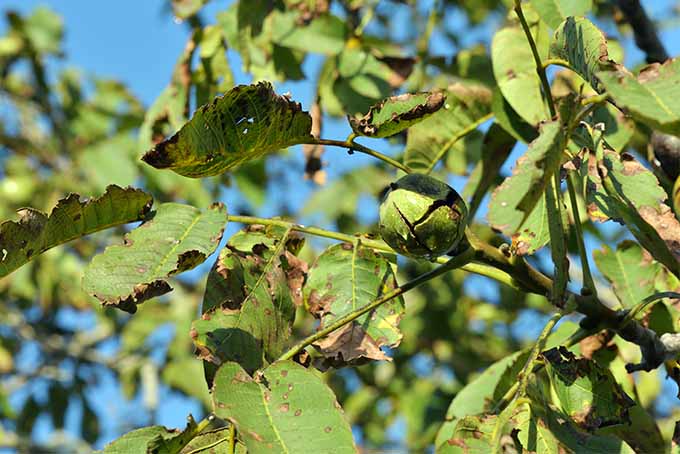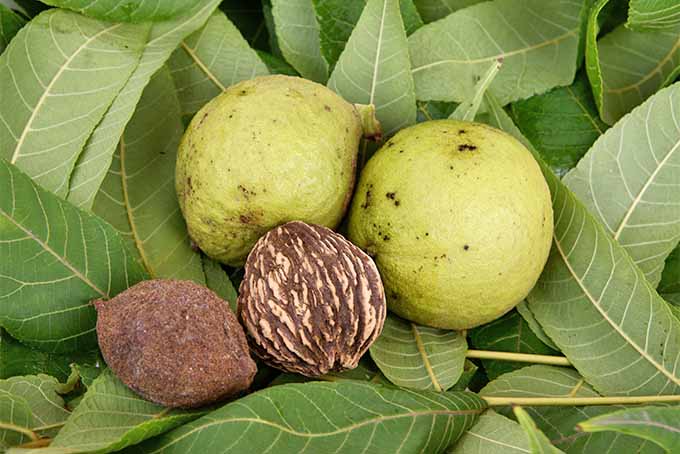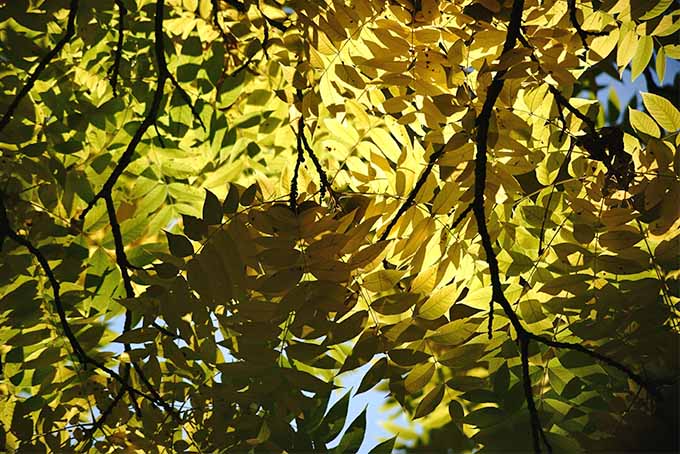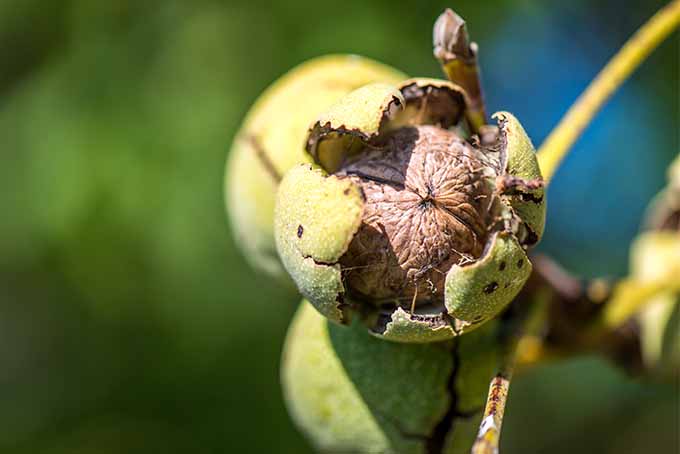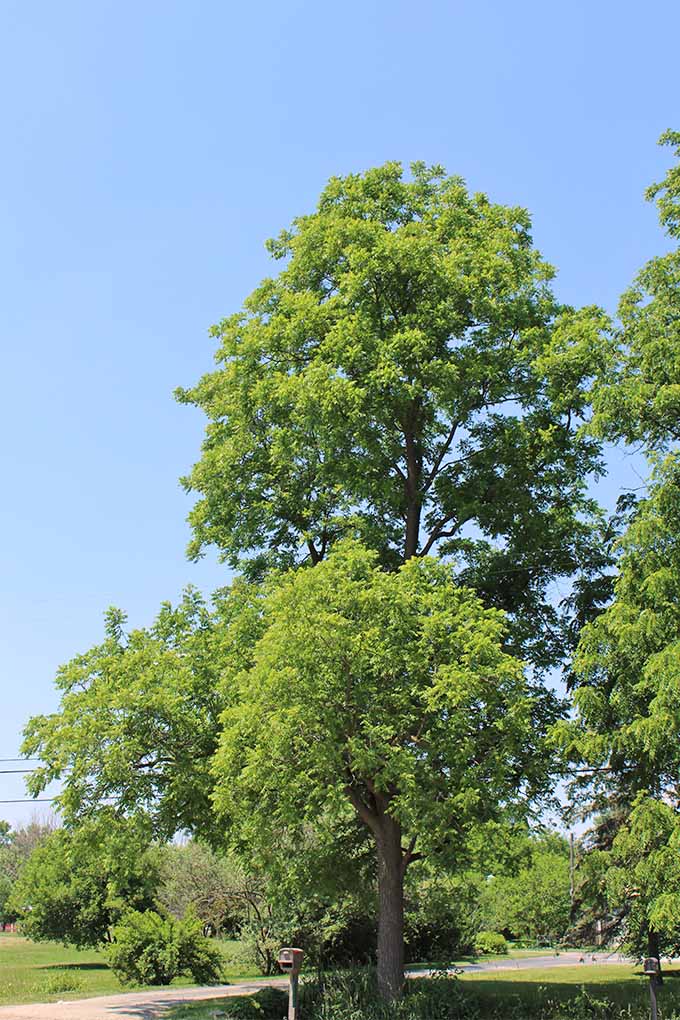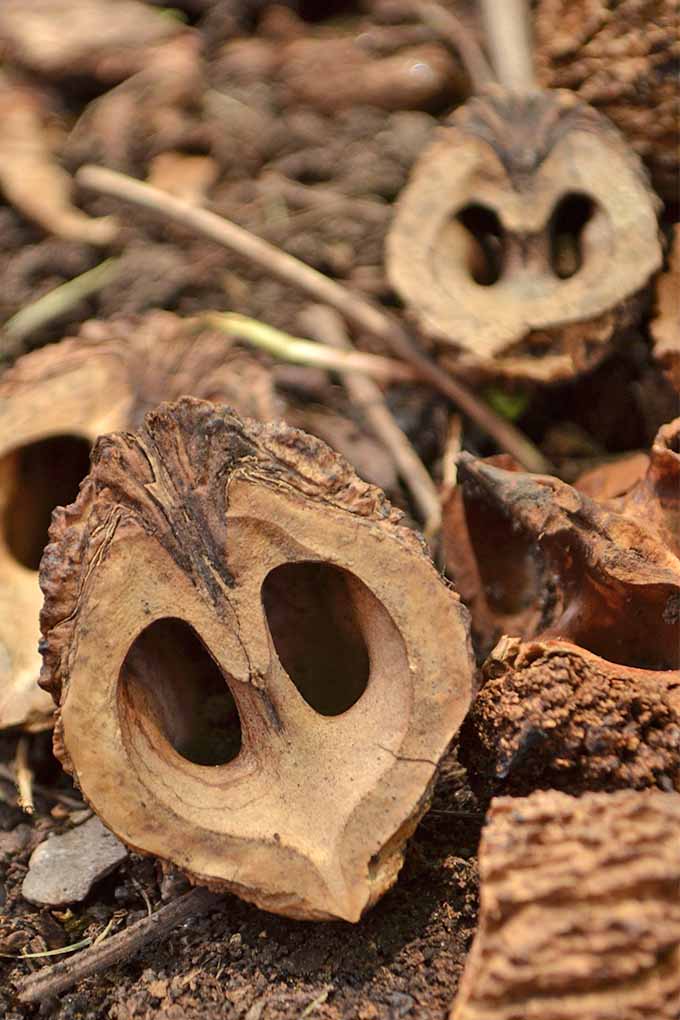While I dreamt of each season’s bounty and Gram’s famous black walnut brownies, I didn’t know that these tasty nuts came with a price. It wasn’t until my husband and I were well into the landscaping plans of our own 4-acre homestead that we started to notice trouble. Several of our newly-planted apple trees weren’t doing well. While the cherries, pears, and plums thrived, these poor saplings were wilting, stunted, and sad.
The adjacent property had a large walnut tree within 50 feet of our infant orchard. While I had occasionally admired the majestic stature of this tree (and secretly hoped for walnuts to fall on our side of the property line), I didn’t realize that my sudden tree deaths were related to its presence. Though many I’ve talked to are unaware of its existence, black walnut trees utilize a special survival method that can be fatal to surrounding flora.
What Makes Black Walnuts Toxic?
A chemical known as juglone is the culprit here. Black walnuts aren’t the only trees that produce this no-nonsense defense system, composed of 5 hydroxy-1, 4- napthoquinone. Hickories (Carya) and butternuts (Juglans cinereal) are also to blame, but black walnut trees are known for having the highest concentrations of the stuff.
Juglone is released from virtually every part of the tree, although the roots, nuts, and seeds are the most toxic. This substance serves a purpose in ensuring the survival of the species, but surrounding plants are often subject to unwanted and undesirable consequences.
How Sensitive Plants React
At first glance, the juglone-sensitive plant may appear to be having other issues. I know that I originally suspected my apple trees were suffering from other maladies. Cedar apple rust is very common here, and it can cause the leaves of apple trees to become mottled and frail.
When trees started dying, however, I knew this was a cause for concern. Apples 40 feet away from the neighbor’s black walnut were in various stage of expiration. Only the trees growing outside the 60-foot marker, on the other side of our property, were thriving. If you’re not familiar with the symptoms of juglone toxicity, you may also attribute it to something else. According to the Morton Arboretum, your plants, trees, and shrubs may exhibit:
Wilt Yellowing of leaves Stunted or slow growth Death – sometimes within a few months of exposure
There is no cure for juglone poisoning. The best thing you can do is avoid planting near black walnut trees!
Plants with a Chance of Survival
Not all plants are sensitive to the environment near the tree. But which ones are resistant? If you look at those that grow wild near volunteer juglone producers, you’ll have your answer!
When I look outside at the natural, wooded areas of my childhood home, I see plenty of these thriving – often within a foot or two of the trees in question.
Tolerant Trees
Included in the “tolerant” category are the following trees:
American Elm Black Cherry Dogwood (includes flowering) Eastern Red Cedar Hickory Locust (most types) Maple (except silver maple) Oak Ohio Buckeye River Birch Sycamore Virginia Pine Yellow Poplar
For the full list, see the Penn State Extension’s guide.
Tolerant Shrubs and Bushes
These shrubs have been identified as resistant to juglone in soil:
American Holly Azalea (most types) Black Raspberry Currant Elderberry Juniper St. John’s Wort Snowball Hydrangea Sumac Witch Hazel
The rest of the list can be accessed via the link referenced above.
Tolerant Fruits and Vegetables
You’re safe to grow these around your black walnut tree:
Beans Cherries Corn Melons Onions Quince Root vegetables (beets, carrots, parsnips) Squash Stone fruits (nectarines, peaches, plums)
Tolerant Flowers and Vines
The list of flowering plants that can handle being planted next to black walnut is rather long. Enjoy these blooming plants and vines without worry:
Bee Balm Bleeding Heart Daffodil Chrysanthemum Crocus Hosta Iris Jack-in-the-Pulpit Jacob’s Ladder Jerusalem Artichoke Lamb’s Ear Morning Glory Pansy Pot Marigold Purple Coneflower Sunflower Tuberose Tulip Virginia Creeper Wild Grape Violet Yarrow Zinnia
Plus, there are dozens of others listed by the Penn State Extension.
Help for Established Gardens and Orchards
So, what if you are in the same situation as I was? What if you have established gardens or orchards, and cannot move the walnut or the affected plants? While success rates in mitigating the damage caused by juglone are low, there are some things you can try.
Start by ensuring that the seeds, leaves, and nuts of the walnut do not come into direct contact with your sensitive plants. This may mean installing a protective balcony, fence, or other physical barrier that allows for sunlight and water to come through – but not toxic tree droppings. In our case, bird netting did keep some of the larger debris that fell from the tree away from plants that were too fragile to be moved right away. If your plants are growing in soil directly above or near the roots of a walnut tree, you can try a raised bed system.
While this won’t work for trees or many shrubs, flowers and veggies can be put in a box or container with soil taken from elsewhere. Assuming there is a protective barrier from the soil placed underneath (nontoxic landscape cloth should work), you can keep your soil toxin-free. One final tip is to keep soil well-drained and adequately watered. Flushing the toxins out of the soil can dilute their effects over time. But this is not a 100% guaranteed solution. The best plan is to keep plants outside of the 50-foot radius that is known to be harmful to them. It’s also very important that you know where your fertilizer, compost, and mulch come from. Anything that may contain black walnut tree matter poses a risk.
Why Walnuts?
In light of all of this fuss, it may seem that it is just simpler to make sure you don’t have any of these trees on your property. I strongly disagree with this sentiment. I grew up with these majestic trees providing wind protection, shade, and tasty nuts every year. They have a long history of affecting the environment in a positive way, and I believe they should be accommodated, if possible. On the other hand, not everyone has the space to allow for such a fickle tree.
If your lot is particularly small, and you do decide that the tree has to go, be mindful of the roots. They can stay in the soil for years, continually releasing juglone into the surrounding area until they finally completely their decay process. Ridding yourself of the great walnut may not be the total solution you were looking for! Do you have one of these trees in your yard or on your homestead? We’d love to hear about what you’ve done to create an ecosystem where both tree and garden can coexist. © Ask the Experts, LLC. ALL RIGHTS RESERVED. See our TOS for more details. Uncredited photos: Shutterstock.

